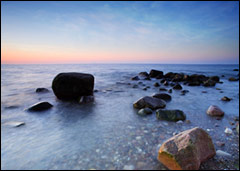Dear Umbra,
Much is made of wind, solar, geothermal, and even wave power, but why doesn’t anyone talk about tidal power? It has more power than wind for the same turbine, without the eyesore of turbines, is totally renewable, and is predictable hundreds of years in advance. Yet nobody talks about it. What’s wrong with tidal?
Chris Morrison
London, England
Dearest Chris,
The tides appear fruitful, but we disturb the ocean at our peril.

Do oceans hold the answer?
Photo: iStockphoto
One concern is that tides follow the lunar cycle, but human power use is linked to the solar cycle. There are two low and two high tides per day, broadly speaking, and their height varies depending on the positions of the moon and sun (tide height being a vertical measurement, not an up-the-beach measurement). Tidal amplitude — the difference between high and low tide — varies with coastal location, and 40 assorted planetary areas where water shoves itself into a bay or estuary have amplitudes suitable for tidal power generation. La Rance, France, is such a place, home to the oldest, largest, and practically only tidal barrage on Earth.
Jargon, ho!: A tidal barrage seems to be a pseudo-dam, with a substantial basin behind it, the sluice gates of which admit water as the tide rises. When the basin fills and a good “head” (differential between water height fore and aft) is established, the sluice gates shut, the water flows out through a turbine, and voila, les kilowatts.
The La Rance turbine spins as water goes both in and out, to maximize and consistentize power, and it has pumps that contribute toward the same end. To look at the numbers: La Rance’s peak tidal amplitude is 13.5 meters, the barrage is 750 meters long, and it produces 600 million kilowatt-hours yearly, sufficient for 250,000 French domiciles.
The troubles with barrages include their incredibly high installation costs, which dwarf their low operating costs, give them long payback periods, and make them poor competitors in the current power market; the conundrum of intense but inconstant power generation, somewhat akin to wind; and the ecological interference inherent in blocking an estuary. Two sample eco-problems are: Estuaries themselves move over time as ocean sediment is removed and replaced, and animals and plants come and go from the estuary; both of these functions are impaired, with unpopular results.
The contemporary approach to tidal power (the La Rance barrage was built in the 1960s) tries to avoid ecological and financial limitations, and eschew the barrage, via development of underwater turbine systems resembling contained windmills. It is also called “marine current” technology, since it relies on underwater currents running at about 5 knots. These are already being tested in some areas, and according to some, look promising both for power and for not pureeing or otherwise badly disturbing animals. They do share the barrage’s trouble of high installation costs and hence high power costs, and others believe this to be a death knell to all tidal power.
All that said, I don’t know why no one talks about the highly interesting topic of tidal power. You could bring it up at summer barbecues yourself, you know.
Neaply,
Umbra

